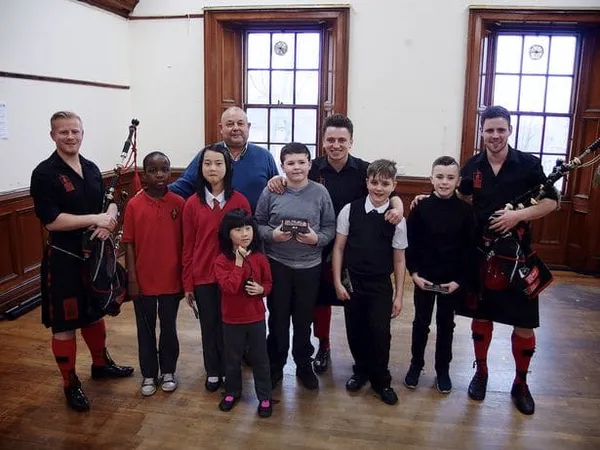Eye For Film >> Movies >> The Wee Govan Pipers (2015) Film Review
The Wee Govan Pipers
Reviewed by: Jennie Kermode

In Finland it's the violin; in Argentina, the guitar; in China, the pipa - all national instruments celebrated for their cultural value, played on ceremonial occasions and widely taught in schools. Think of Scottish music and you'll think of the bagpipes, but did you know that only 10% of children taught in state-funded Scottish schools have the chance to learn them? The Wee Govan Pipers are learning in their community from a tutor who was once a champion. Cultural revivals have to start from the ground up, he says. They have to begin with the children.
The Govan project, whose small size, like that of its pupils, is dwarfed by its spirit and ambition, evidences the multiethnic cultural revival going on across Scotland's arts scene, a celebration of community that is all about where people find themselves now rather than where they came from. To put it in context, Govan is only four square miles in size; it can trace back 1,300 years of history, not all of it pretty, but people speak of having fallen in love with it after living there for just a few months. The ten-year-old pipers have a wide range of backgrounds. Tam is Govan born and bred, a little shy but gradually discovering the depth of his talent. Damilola has recently arrived from Nigeria and has a lot of natural ability but is realising that he needs to practice hard if he wants that to matter. Brenda, whose family comes from China, is the kind of kid who could probably succeed at anything she put her mind to, and the tutor sees her as someone who could go all the way to the top. But she's one of very few girls involved in piping, and over the course of the film she explains how that makes her feel, and meets one of the legendary players whose work made way for women to participate in competition.

All of the children are endlessly charming, to the point where one wonders what has been edited out - they seem too good to be true. The benefits that piping has given them are clear. David's family talk about how it has boosted his confidence and helped him to become more assertive. Scott's discuss its physical benefits - although he has asthma, his lung capacity is now increasing and he hasn't had to use his inhaler for weeks. There's also a strong sense of camaraderie within the team, especially apparent when five of them travel to a contest where only four will be able to play. As they film one another and talk to members of the public, it becomes apparent that skills they are picking up go beyond piping itself, and that their sense of being team players is helping them create that spirit within the wider Govan community.
it's understandable that some people will hesitate to watch an hour long film about bagpipes, especially when they're played by children - and it's impossible to make a film about learning without illustrating the mistakes made along the way, but all in all these are not as hard on the ears as one might expect. For all their budding talent, the children are not first class musicians - they have a lot of learning still to do - but by and large the music is pleasant and occasionally it's very good. The real focus, however, is on its cultural value and the joy it brings. Despite occasional moments when this feels a bit like a programme made for schools, it is generally very natural and engaging, with a lot of energy. It's likely that it will win quite a few converts to the pipes, and it makes for an intriguing portrait of the place of tradition in contemporary Scotland.
Reviewed on: 21 Jan 2017















